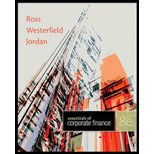
Essentials of Corporate Finance
8th Edition
ISBN: 9780078034756
Author: Stephen A. Ross, Randolph W. Westerfield, Bradford D. Jordan
Publisher: MCGRAW-HILL HIGHER EDUCATION
expand_more
expand_more
format_list_bulleted
Question
Chapter 6, Problem 6.2ACQ
Summary Introduction
To discuss: The difference between debt and equity.
Introduction:
Debt refers to the money borrowed by the borrower at a fixed interest rate. The borrower is liable to repay the debt. A bond is an example of a debt security.
Equity refers to the share in the capital or ownership of the company.
Expert Solution & Answer
Want to see the full answer?
Check out a sample textbook solution
Students have asked these similar questions
10. Calculate the break-even point for a company with fixed costs $10,000, variable costs $5/unit, and selling price $10/unit.
no gpt ..???
7. If sales are $500,000 and gross profit margin is 30%, what is the cost of goods sold?
3. If a stock's beta is 1.5 and the market return is 12%, with a risk-free rate of 4%, what is the expected return?
Chapter 6 Solutions
Essentials of Corporate Finance
Ch. 6 - What are the cash flows associated with a bond?Ch. 6 - What is the general expression for the value of a...Ch. 6 - Is it true that the only risk associated with...Ch. 6 - Prob. 6.2ACQCh. 6 - Prob. 6.2BCQCh. 6 - Prob. 6.2CCQCh. 6 - What is a junk bond?Ch. 6 - What does a bond rating say about the risk of...Ch. 6 - Prob. 6.4ACQCh. 6 - What do you think would be the effect of a put...
Ch. 6 - Prob. 6.5ACQCh. 6 - Prob. 6.5BCQCh. 6 - Prob. 6.5CCQCh. 6 - Prob. 6.6ACQCh. 6 - Prob. 6.6BCQCh. 6 - What is the term structure of interest rates? What...Ch. 6 - Prob. 6.7BCQCh. 6 - What are the six components that make up a bonds...Ch. 6 - Prob. 6.1CCh. 6 - Prob. 6.2CCh. 6 - Prob. 6.3CCh. 6 - Prob. 6.4CCh. 6 - Prob. 6.5CCh. 6 - Prob. 6.6CCh. 6 - Prob. 6.7CCh. 6 - Prob. 1CTCRCh. 6 - Prob. 2CTCRCh. 6 - Prob. 3CTCRCh. 6 - Prob. 4CTCRCh. 6 - Prob. 5CTCRCh. 6 - Prob. 6CTCRCh. 6 - Prob. 7CTCRCh. 6 - Prob. 8CTCRCh. 6 - LO3 6.9Bond Ratings. Often, junk bonds are not...Ch. 6 - Crossover Bonds. Looking back at the crossover...Ch. 6 - Municipal Bonds. Why is it that municipal bonds...Ch. 6 - Prob. 12CTCRCh. 6 - Prob. 13CTCRCh. 6 - Prob. 14CTCRCh. 6 - Prob. 15CTCRCh. 6 - Prob. 1QPCh. 6 - Interpreting Bond Yields. Suppose you buy a 7...Ch. 6 - Prob. 3QPCh. 6 - Prob. 4QPCh. 6 - Prob. 5QPCh. 6 - Prob. 6QPCh. 6 - Prob. 7QPCh. 6 - Prob. 8QPCh. 6 - Prob. 9QPCh. 6 - Prob. 10QPCh. 6 - Prob. 11QPCh. 6 - Prob. 12QPCh. 6 - Prob. 13QPCh. 6 - Prob. 14QPCh. 6 - Prob. 15QPCh. 6 - Prob. 16QPCh. 6 - Prob. 17QPCh. 6 - Prob. 18QPCh. 6 - Prob. 19QPCh. 6 - Prob. 20QPCh. 6 - Prob. 21QPCh. 6 - Prob. 22QPCh. 6 - Prob. 23QPCh. 6 - Prob. 24QPCh. 6 - Prob. 25QPCh. 6 - Prob. 26QPCh. 6 - Prob. 27QPCh. 6 - Prob. 28QPCh. 6 - Prob. 29QPCh. 6 - Prob. 30QPCh. 6 - Prob. 31QPCh. 6 - Prob. 32QPCh. 6 - Financing SS Airs Expansion Plans with a Bond...Ch. 6 - Financing SS Airs Expansion Plans with a Bond...Ch. 6 - Financing SS Airs Expansion Plans with a Bond...Ch. 6 - Financing SS Airs Expansion Plans with a Bond...Ch. 6 - Financing SS Airs Expansion Plans with a Bond...Ch. 6 - Financing SS Airs Expansion Plans with a Bond...Ch. 6 - Financing SS Airs Expansion Plans with a Bond...Ch. 6 - Financing SS Airs Expansion Plans with a Bond...Ch. 6 - Financing SS Airs Expansion Plans with a Bond...Ch. 6 - Financing SS Airs Expansion Plans with a Bond...
Knowledge Booster
Similar questions
- 4. A company has $100,000 in assets and $50,000 in liabilities. What is its equity? Need a helpful..???arrow_forward4. A company has a debt-to-equity ratio of 1:2. If debt is $200,000, what is equity?arrow_forward9. If a company's current ratio is 2 and its current liabilities are $50,000, what are its current assets?no chatgpt???arrow_forward
- 5. Calculate the return on equity (ROE) for a company with net income $150,000 and equity $750,000.arrow_forward6. What is the price of a bond with face value $1,000, coupon rate 8%, and market interest rate 10%?arrow_forward9. A company has fixed costs $50,000, variable costs $10/unit, and sells products at $20/unit. What is the break-even point?arrow_forward
- 8. Calculate the weighted average cost of capital (WACC) for a company with 60% equity (cost 12%) and 40% debt (cost 8%). no gpt ..???arrow_forward8. Calculate the weighted average cost of capital (WACC) for a company with 60% equity (cost 12%) and 40% debt (cost 8%). Need a helpful..??arrow_forward3. If a company's net income is $100,000 and it has 10,000 shares outstanding, what is the earnings per share (EPS)? Correctly answer..???arrow_forward
- 10. If a stock's dividend yield is 5% and stock price is $100, what is the annual dividend payment? no gpt..???arrow_forward8. A stock has a beta of 1.2 and the market return is 10%. If the risk-free rate is 2%, what is the expected return? need a ai ..???arrow_forwardA corporation buys on terms of 2/8, net 45 days, it does not take discountes, and it actually pays after 62 days, what is the effective annual percentage cost of its non-free trade credit? Use a 365-day year) keep to the 6th decimal place for accuracyarrow_forward
arrow_back_ios
SEE MORE QUESTIONS
arrow_forward_ios
Recommended textbooks for you
- Principles of Accounting Volume 1AccountingISBN:9781947172685Author:OpenStaxPublisher:OpenStax College


Principles of Accounting Volume 1
Accounting
ISBN:9781947172685
Author:OpenStax
Publisher:OpenStax College
